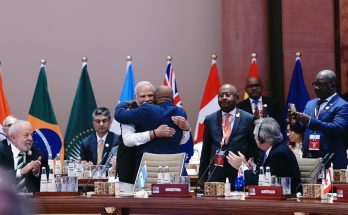Flying from the Sudanese capital Khartoum to the mineral-rich western province of Darfur, the seat of an unfolding humanitarian crisis, is like travelling into another country and time zone. A vast sprawling desert glints in the merciless sun and, blurring the thin dividing line between fact and fiction.
All the noise and bustle of a burgeoning metropolis recedes. An eerie silence envelops your senses, begetting questions that no one has straight answers to.
Fed on the horror stories of endemic violence that has put Darfur, bordered by Libya in the north and Chad and Central African Republic in the south, on the conscience map of the world, one looks for telltale evidence.

When are the janjaweeds – the infamous horse and camel-mounted militia slaughtering innocents that populate contemporary folklore about Darfur – going to come? You wait and wait, but all you see are some refugee camps and the soporific hum of a North African small town left to stagnate in the desert wilderness.
The contrast between Khartoum and Darfur, a region that is larger in size than France and rich in oil and minerals like uranium, iron, tin and bauxite but has been embroiled in bloody feuding among nomads and settled farmers, gets accentuated as you drive around on rain-splashed sand roads in El-Fasher, the capital of North Darfur.
Typical small-town sights roll by: hawkers selling cheap food, bright-eyed school children playing in fields, and locals swapping gossip and drinking tea. Pick-up vans carrying heavily armed military men sporadically shatter the silence, a reminder that one has entered a conflict zone. But some myths fall by the wayside. You can’t distinguish easily between Arabs and Africans (Darfur’s six million people are affiliated to 30 odd tribes most of whom are Sunni Muslims) and you don’t notice bloodlust in their eyes either.
The conflict is for real and it feeds partly on ethnic rivalries (Darfur is named after the Furs, the dominant tribe; Zagahwa and Massalit are some of the more important tribes in the region) and partly on a fiercely competitive battle for land and water that the region is woefully short of. Darfur, now divided into three states, was neglected for decades first under the Anglo-Egyptian rule between 1917 to 1956, and then the powers-that-be in Sudan who concentrated on developing the K triangle comprising Khartoum, Kosti and Kassala at the cost of Darfur after it became independent in 1956.
Khartoum was also busy in combating a civil war that raged in the black-dominated South Sudan for nearly two decades till a peace agreement was signed two years ago. Rebels in Darfur started a fight for a better deal for indigenous people in 2002 with some rebel factions demanding a separate state.
A visit to Abu Shoack camp in El-Fasher for internally displaced persons shakes one out of torpor induced by desert heat and brings you face to face with the indelible scars of Darfurians, who otherwise have a reputation as ferocious fighters. Nearly 54,000 people are living in this camp, which is being managed by a coalition of NGOs, UN agencies like the World Food Programme and the UNICEF with assistance from the Sudan government.
 Women and children, inured to the wrenching pain of displacement, peer blankly from their little enclosures and think their visitors are from one of the aid agencies.
Women and children, inured to the wrenching pain of displacement, peer blankly from their little enclosures and think their visitors are from one of the aid agencies.
Ibrahim al-Khalil, the camp manager, says they are being looked after well, and some of them are even living a better life than the one they were used to before the mayhem struck.
This picture of deprivation changes when one reaches the stately white mansion of Mohammed Usman Yusuf Kibir, the governor of North Darfur, which is located close to the garrison of the Sudanese armed forces.
As innocent-eyed gazelles gambol casually in the lush lawns of the governor’s house, the powerful wali (governor) of North Darfur turns on his PR charm. He brushes aside ‘all the BBC-CNN talk’ of genocide and fixes us with a hard look.
‘It’s basically a battle for land and water. When nomads’ animals stray into farmers’ lands, fighting starts,’ he says, dismissing reports of violence as local crime cases of robbery and kidnapping.
‘The security has improved and people are returning. That doesn’t mean we don’t have problems,’ said the tall, dark and imposing governor as he jabs his fingers in the air and vehemently contests the figures of the dead and the displaced in the Darfur conflict that is bandied around in the West.
There are many conflicting casualty estimates illustrating the perils of information war in a media-driven age, with the UN saying that the conflict has left as many as 450,000 dead from violence and disease since the crisis erupted four years ago. Most NGOs put the number of the dead at between 200,000 and 400,000 and internally displaced people at 2.5 million people.
‘It can’t be more than 50,000 dead, including those who died from disease, and internally displaced persons are at a little over 100,000,’ says Kibir.
‘It’s all about oil,’ he says, echoing a popular conspiracy theory in Khartoum which thinks the US is trumpeting a case of humanitarian disaster in Darfur with a larger agenda of dismembering Sudan and capturing its flourishing oil industry.
Sudan has so far managed to survive the decade-old US sanctions with more than a little help from China, the largest investor in Sudan’s booming oil industry, with total bilateral trade exceeding $10 billion. It has also woken up to the perils of underdevelopment of Darfur with President Omer al-Bashir announcing in July the decision to build Western Salvation Highway to link Niyala, capital of south Darfur, to Omdurman, old city of Khartoum.
The enterprising man he is, the governor points to a group of well-fed Lebanese investors waiting to meet him and dreams aloud of hotels and supermarkets and other infrastructure that will come up in Darfur, which has no direct road link to Khartoum yet.
These mall dreams may, however, have to wait for peace to return to the region. Negotiations between the government and those rebels who did not sign the Darfur Peace Agreement last year, inked between the Sudanese government and the largest rebel group Sudan Liberation Movement led by Mini Menawai, are going to begin next month.
Darfurians hope that the hybrid United Nations-African Union force comprising 26,000 odd troops, which is likely to be deployed in the region over the next year, could do the trick. But given Darfur’s grim history of lost chances, it’s a hope that can as easily sink into desert sands and turn out to be a mirage.
Author Profile

- Manish Chand is Founder-CEO and Editor-in-Chief of India Writes Network (www.indiawrites.org) and India and World, a pioneering magazine focused on international affairs. He is CEO/Director of TGII Media Private Limited, an India-based media, publishing, research and consultancy company.
Latest entries
 India and the WorldJuly 9, 2024Defying West, India sets $100 billion trade target with Russia
India and the WorldJuly 9, 2024Defying West, India sets $100 billion trade target with Russia India and the WorldJuly 5, 2024India at SCO: Takes swipe at Pakistan for cross-border terror, pushes alternative to BRI
India and the WorldJuly 5, 2024India at SCO: Takes swipe at Pakistan for cross-border terror, pushes alternative to BRI India and the WorldJune 14, 2024Modi’s Day 1 in Italy: Bonding with Britain, France
India and the WorldJune 14, 2024Modi’s Day 1 in Italy: Bonding with Britain, France India and the WorldJune 13, 2024G7 summit in Italy: Modi to showcase India as leader of Global South
India and the WorldJune 13, 2024G7 summit in Italy: Modi to showcase India as leader of Global South






